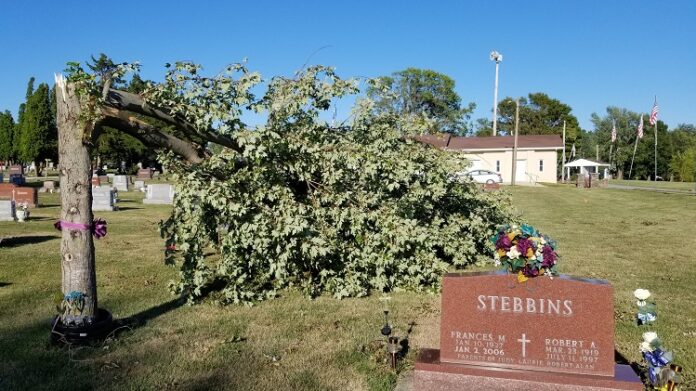That one hurt the most. The tree planted over 20 years ago near my dad’s grave. The one on which I tie a ribbon to match the season. The one my brother cares for. The one planted after the city cut down the row of trees lining the edge of Violet Hill Cemetery. Mom upset the first time she visited and experienced the bareness — the trees being the reason that location was chosen.
The trees at Violet Hill were a link to the trees my parents planted every year on their farm. Trees my mom carried buckets of water to.
There was dad’s modification of the water buckets — holes drilled into the buckets so they could be set near a tree and let the water trickle into the ground.
There was the weeping willow tree with a short life span. Mom got a bit too close with the riding mower and snapped it over. Oddly enough, jumping off the mower and standing it back up did not make the tree meld together.
The oaks, maples, red buds and more. Family trips to Earl May followed by planting the trees as a family. Always room in the yard for more trees.
Tree selection and tree planting was a known ritual like walking beans, a day at Riverview Park — the Adventureland of its day — and the Iowa State Fair.
These rituals were family time, but there are rituals of another purpose. Rituals I found comforting at a time of death — buying my dad trees. Trees in memory planted in a National Park with a need. Trees on his birthday, Father’s Day and other significant dates.
The ritual. The memories. His love of trees.
Many trees were planted by my parents on their farm or have been planted in parks across the United States both in their memory and the memory of others.
And yet, that tree. Somehow it was as if they left me a bit all over again.
It made me even sadder for every tree we’ve lost in Perry and across Iowa. Each of them with multiple stories, memories, connections to us.
The ritual and the memories remain. New trees will be planted and grow in memory of my parents. New trees planted for your specific memories. New trees planted to make more memories and connections.


















If you want to replace the tree with itself here is how to do it from the fallen tree.
How to Root Hardwood Cuttings
Hardwood cuttings are typically taken in early spring or early winter when the plant is not actively growing. But, in a pinch, hardwood cuttings can be taken anytime of the year. The point of taking hardwood cuttings in non-growth periods is more to do with doing as little harm to the parent plant as possible. Hardwood cuttings are also only taken from shrubs, bushes and trees that lose their leaves every year. This method will not work with evergreen plants. Cut off a hardwood cutting that is 12 to 48 (30-122 cm.) inches long. Trim the end of the cutting to be planted just below where a leafbud grows on the branch. Cut off the top of the branch so that there are at least two additional leafbuds above the bottom leafbud. Also, make sure that the area left is at least 6 inches (15 cm.) long. Additional buds can be left on the branch if necessary to make sure the branch is 6 inches (15 cm.). Strip the bottom most leafbuds and the topmost layer of bark 2 inches (5 cm.) above this. Do not cut too deeply into the branch. You only need to take off the top layer and you do not need to be thorough about it. Place the stripped area in rooting hormone, then put the stripped end into a small pot of damp soilless mix. Wrap the whole pot and cutting in a plastic bag. Tie off the top but make sure the plastic is not touching the cutting at all. Place the pot in a warm spot that gets indirect light. Do not put in full sunlight. Check the plant every two weeks or so to see if roots have developed. Once roots have developed, remove the plastic covering. The plant will be ready to grow outdoors when the weather is suitable. How to Root Softwood Cuttings Softwood cuttings are normally taken when the plant is in active growth, which is normally in the spring. This will be the only time you will be able to find softwood on a shrub, bush or tree. This method can be used with all types of shrubs, bushes and trees. Cut a piece of softwood off the plant that is at least 6 inches (15 cm.) long, but no longer than 12 inches (30 cm.). Make sure that there is at least three leaves on the cutting. Remove any flowers or fruit on the cutting. Trim the stem to just below where the bottom most leaf meets the stem. On each of the leaves on the stem, cut off half of the leaf. Dip the end of the cutting to be rooted in rooting hormone Put the end to be rooted into a small pot of damp soiless mix. Wrap the whole pot and cutting in a plastic bag. Tie off the top but make sure the plastic is not touching the cutting at all. Place the pot in a warm spot that gets indirect light. Do not put in full sunlight. Check the plant every two weeks or so to see if roots have developed. Once roots have developed, remove the plastic covering. The plant will be ready to grow outdoors when the weather is suitable.